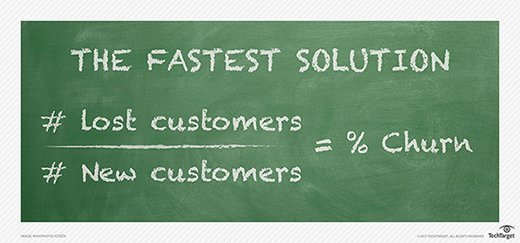churn rate
What is churn rate?
Churn rate is a measure of the number of customers or employees who leave a company during a given period. It can also refer to the amount of revenue lost as a result of the departures.
Changes in a business's churn rate can provide valuable insight into the organization. The customer churn rate may indicate the response to its services, customer satisfaction, pricing and competition; reflect on employee morale; or provide insight into the average length of time an individual remains a customer or employee. As such, churn rate is an important business metric.
To estimate future churn rates, predictive modeling technology is sometimes applied in a process known as predictive churn modeling.
Calculating churn rate
The employee turnover or customer churn rate formula calls for an organization to divide the number of customers or employees who left the company during a specified time period by the total number there was at the start of the time period. For example, if a company has 1,000 employees at the start of a quarter and 800 at the end, you would divide 200 by 1,000 to determine the employee churn rate as 20%.
There are two forms of revenue churn:
- Gross revenue churn. Also referred to as a gross monthly recurring revenue (MRR) churn rate, this measures revenue lost due to customer cancellations or downgrades during a given time period. The gross revenue churn rate can be determined by subtracting the revenue at the end of the time frame from the revenue at the beginning of the same span of time, then dividing the resulting number by the revenue at the start of the period.
Initial revenue - Revenue at the end of the period / Initial revenue = Gross revenue churn rate
- Net revenue churn. Also known as the net MRR churn rate, this measures the revenue lost from customers who canceled or downgraded their services, mitigated by new revenue from existing customers. To calculate the net revenue churn rate, subtract all revenue lost from cancellations or contractions, as well as all revenue gained from upgrades and add-ons by current customers, from the initial revenue, then divide the resulting number by the revenue at the start of the period.
Initial revenue - Revenue lost - Revenue gained from upgrades / Initial revenue = Net revenue churn rate
What is customer churn?
Customer churn is an ongoing concern for subscriber-based services companies, particularly telephone and cell phone services, in areas where several companies compete and make it easy to transfer from one service to another. Calculating and tracking churn rate can help telecommunications organizations assess how they're performing against competitors, and adjust strategies to enhance and bolster subscriber loyalty.
Experts claim it costs more to attract new customers than it does to retain current customers. Current customers are far more likely to buy products than new customers. Tracking customer churn rates in e-commerce can help companies develop strategies to enhance and retain customers, thereby lowering costs typically associated with onboarding new customers.

What is employee churn?
The terms employee churn and employee attrition are used interchangeably but are technically different. Employee attrition refers to the loss of an employee who is not replaced, resulting in workforce reduction. An example of this is a corporate layoff to eliminate certain positions or departments. Employee churn, or turnover, refers to the rate at which employees leave a company and must be replaced by new employees.
Some industries, such as fast food and contact centers, deal with high employee churn rates as a matter of course. The average contact center, for example, has an annual employee attrition rate as high as 40% and the total cost of replacing an employee can get expensive for businesses.
To closely track employee churn, some contact centers divide turnover into subcategories, such as part-time and full-time; unplanned and planned turnover, such as retirement; and voluntary or involuntary.
Involuntary employee turnover typically refers to termination due to poor job performance or other fireable offenses.
Editor's note: This article was written by Jacqueline Biscobing in 2017. TechTarget editors revised it in 2023 to improve the reader experience.








